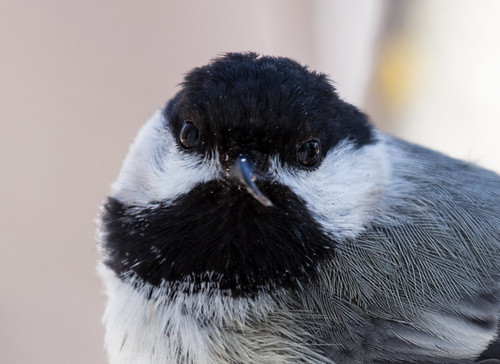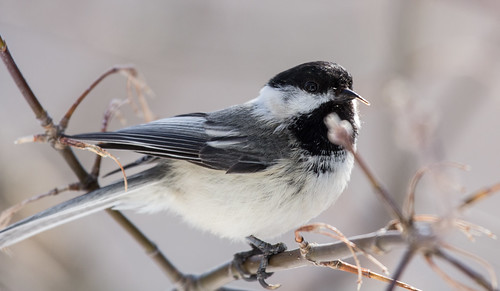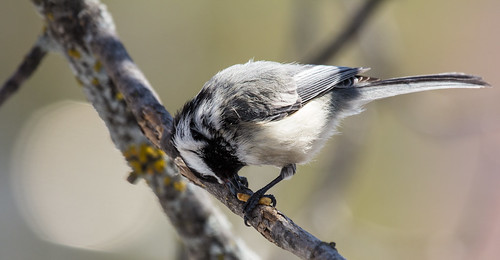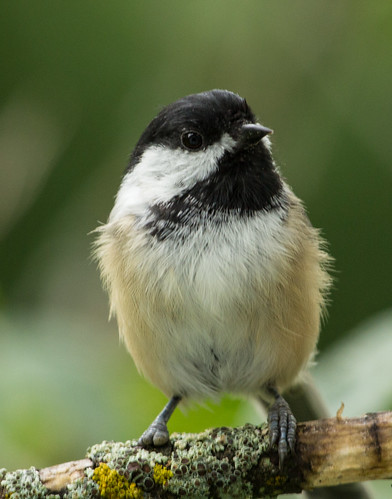 |
| MY chickadee—the one with the deformed bill and foot—at his nest! |
At the end of my conservation big year in 2013, I started noticing a chickadee in my yard whose bill had become overgrown—the kind of deformity that has been woefully common in Alaska, so the
USGS’s Alaska Science Center has been keeping track of all chickadees with deformed bills. Their data comes mostly from Alaska, but a handful of records are from elsewhere.
 |
| This same chickadee in April 2014 |
 |
| Same guy in April 2014 |
I took lots and lots of photos of my little guy, which was relatively easy because he takes mealworms out of my hand. Because the tips of his bill didn’t meet properly and the upper bill extended so far beyond the lower, he had a lot of trouble picking up and eating food. But he could easily grab mealworms out of my cupped hand, and I was spending so much time at my computer, next to the window, as I finished up writing my
nesting book, that whenever he wanted food, I’d notice right away.
Of course, even in the middle of a book project I can’t stay at my office desk every moment of daylight hours, so when I wasn’t going to be there, I’d put some mealworms into a little window feeder. At first, the mealworms had to be piled up more than 2 or 3 millimeters thick for him to easily grasp them—his lower bill had to be able to reach them in order to take one—but little by little, I noticed that he was learning to turn his head upside down and slide the upper bill under a mealworm until the lower bill could close on it. He must have had at least a little trouble preening with the deformity, but didn’t look very scruffy except one side of his face.
 |
| He had to turn his head upside down to eat the mealworms, too. |
My guy made it through the winter and exceptionally cold, long spring, and I was thrilled—and then suddenly I stopped seeing him. Well, not quite—I stopped seeing a chickadee with a very long upper bill. But he was still there—it took me a couple of days to figure out that the bill tip had broken off, and his bill looked almost normal. The upper tip wasn’t smoothly worn to perfectly match the lower bill, but was working almost perfectly.
Meanwhile, I suddenly was noticing that one chickadee who came regularly to my hand had a badly deformed foot, missing the front three toes. When I put two and two together, I realized that this was the very chickadee whose bill had been deformed. Sure enough, when I went back and studied those photos I’d taken, in every one showing the right foot of the bird with the overly long upper bill, I could see that pitifully deformed foot. Now that I knew about the foot, that chickadee felt way different in my hand—I must have been so keyed in on studying the bill that I simply hadn’t noticed.
 |
| This shows his deformed foot well. |
He clearly faced difficulties in getting food that the other chickadees didn’t, but he had two advantages over them. He trained a human to find food for him, and give it to him whenever he flew to her window and gave her a long, hard stare. And he was trusting enough to remain in my hand long enough to grab two, and then three, mealworms with every trip.
As it turns out, he didn’t train just one human—by this past winter, he started getting mealworms from my neighbor Jeanne Tonkin, too. All along, I noticed that when he flew off with his bounty, he headed over toward the trees behind her house. When she told me she was feeding mealworms, I told her about my guy, and sure enough—he had turned two different people into his personal servants.
He didn’t attract a mate in 2014, and I couldn’t be certain he was a he or a she. This past winter, the upper bill grew just slightly longer—the bill is still slightly unusual, but I have to study it to notice. And this year he did attract a mate. Jeanne noticed before I did that he was feeding a begging chickadee the mealworms he was carrying off. I soon saw him doing that, and also singing. These two behaviors verified that he was a male, and the bird he was feeding had accepted him as a mate. They had to be nesting somewhere, but where?
Jeanne discovered the nest in her backyard a few weeks ago.
 |
| The nest cavity |
It’s in a dead portion of a large cherry tree. The hole is slightly larger than it needs to be—I think it must have been constructed originally by a Downy Woodpecker. Jeanne called me yesterday to tell me about the nest, so I ran right over with my camera, and got lots of photos of both the female and my little guy bringing food in and carrying off fecal sacs. They’ve been feeding mealworms to the nestlings, but also a rich assortment of natural insects and spiders.
 |
| Here's Dad after a feeding bout |
 |
| Mom with a juicy caterpillar |
 |
| Mom carrying out a fecal sac |
 |
| Mom with a spider and other delicacies |
I loved realizing that even though I’d helped keep this particular little bird alive during his worst year, and he is still adept at getting handouts from us, his survival was due not just to our subsidizes but to his own plucky nature. Life is harsh for chickadees, but they’re survivors. Smart ones who know how to capitalize on every little feature of their home range are the ones who make it. What does it matter if one of those features happens to be two trainable women with a supply of mealworms?
 |
| A nestling! |
I got some photos of one of his nestlings near the entrance of the cavity—proof of the tenacity of life and just what a survivor my chickadee has been. The chick was quite well feathered out, so it’ll be fledging any day now. I’m so thrilled that I got to see at least one of my dear little guy’s own dear little guys.











